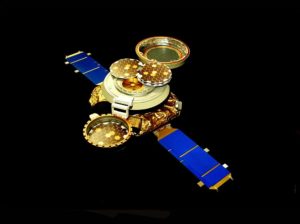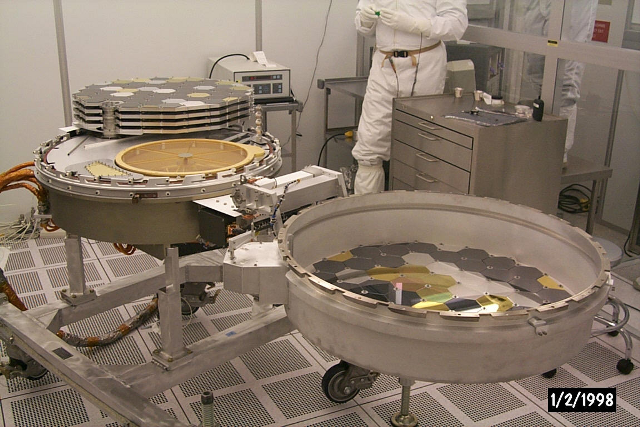Genesis
Researchers interested in meteorites and planetary materials would, ideally, like to have a sample of our original solar nebula to use as a baseline from which to track changes as the Sun and the planets were formed.
Center Emeritus Research Professor Amy Jurewicz is working on samples from NASA’s Genesis sample return mission, which was designed to give us just such a baseline composition by collecting samples of solar wind for two years, prior to a [expand title=”hard landing in Utah.” tag=”u” trigclass=”arrowright” targclass=”div”]In 2004, Genesis team members could only look on as the spacecraft’s parachutes failed to deploy, and the delicate solar wind collectors hurtled toward the Utah desert at over 300 km/hr.
 A flying saucer from outer space crash-landed in the Utah desert after being tracked by radar and chased by helicopters. The year was 2004, and no space aliens were involved. The saucer, pictured here, was the Genesis sample return capsule, part of a human-made robot Genesis spaceship launched in 2001 by NASA itself to study the Sun.
A flying saucer from outer space crash-landed in the Utah desert after being tracked by radar and chased by helicopters. The year was 2004, and no space aliens were involved. The saucer, pictured here, was the Genesis sample return capsule, part of a human-made robot Genesis spaceship launched in 2001 by NASA itself to study the Sun.
The unexpectedly hard landing at over 300 kilometers per hour occurred because the parachutes did not open as planned. The Genesis mission had been orbiting the Sun collecting solar wind particles that are usually deflected away by Earth’s magnetic field.
Despite the crash landing, many return samples remained in good enough condition to analyze. So far, Genesis-related discoveries include new details about the composition of the Sun and how the abundance of some types of elements differ across the Solar System. These results have provided intriguing clues into details of how the Sun and planets formed billions of years ago. Image and caption: Genesis Mission/NASA.
[/expand]

Solar wind samples are a good surrogate for the solar nebula because a preponderance of scientific evidence suggests that the outer layer of the Sun preserves the composition of the early solar nebula.
As Jet Propulsion Laboratory’s Project Scientist for Genesis, Dr. Jurewicz worked closely with the science team to develop collectors for the mission. In addition to physical and chemical testing a range of characteristics, from thermal stability and pre-flight cleaning to diffusion studies, Dr. Jurewicz personally fabricated approximately a quarter of the solar wind collectors used on the [expand title=”Genesis spacecraft.” tag=”u” trigclass=”arrowright” targclass=”div”]The Genesis spacecraft opened for collection of solar wind. 

Jurewicz A. J. G., Laming J. M., and Christoffersen R. (2021) The Genesis Mission: A Unique Opportunity for Scientific Collaboration. 52nd Lunar and Planetary Science Conference. Abst. #1295. https://ntrs.nasa.gov/api/citations/20210000244/downloads/Jurewicz_LPSC2021.pdf
Grimberg et al. (2006) Solar Wind Neon from Genesis: Implications for the Lunar Noble Gas Record. Science. 314 (5802): 1133-1135. https://www.science.org/doi/10.1126/science.1133568
McKeegan K. D. et al. (2011) The oxygen isotopic composition of the Sun inferred from captured solar wind. Science 332(6037):1528‐1532. https://www.science.org/doi/10.1126/science.1204636
Marty B. et al. (2011). A 15N‐poor isotopic composition for the solar system as shown by Genesis solar wind samples. Science 332:1533-1536. https://www.science.org/doi/10.1126/science.1204656
Pilleri P. et al. (2015) Variations in Solar Wind Fractionation as seen by ACE/SWICS and the Implications for GENESIS Mission Results. The Astrophysical Journal, 812:1-10. https://iopscience.iop.org/article/10.1088/0004-637X/812/1/1
Burnett et al. (2015) Ion Implants as Matrix-Appropriate Calibrators for Geochemical Ion Probe Analyses. Geostandards and Geoanalytical Research, 39(3): 265-276. https://onlinelibrary.wiley.com/doi/full/10.1111/j.1751-908X.2014.00318.x
Jurewicz A. J. G. et al. (2023) Space Weathering of Genesis Mission Solar-wind Collectors with Inferences for Weathering on Airless Bodies. The Planetary Science Journal, 4 (5):98, open access. https://iopscience.iop.org/article/10.3847/PSJ/acd33c
Jurewicz A. J. G. et al. (in press Sept. 2024) Differences in Elemental Abundances Between CI Chondrites and the Solar Photosphere. Meteoritics & Planetary Science
